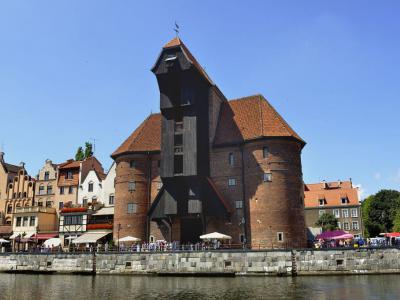Brama Żuraw (Crane Gate), Gdansk (must see)
The silhouette of the great waterfront Crane of Gdansk is a well known symbol of the city. The first wooden crane at the foot of Szeroka Street dates from at least 1367. This structure was destroyed by fire in the 15th century. The replacement brick crane of today was erected in 1444. The brick western facade was not completed until 1483.
The Crane was the largest water gate in the city by far and it still is. The huge crane structure is flanked by two fortified rounded towers. The ground floor of the crane had cannon emplacements. Firing embrasures mark the upper floors.
The lifting mechanism of the crane was made of two pairs of treadwheels on one shaft. Four workers powered each treadwheel. The men walked inside the wheel like human hamsters. This system provided enough muscle power to lift two tons of load to a height of almost 120 feet. The crane was in ever dwindling use until 1944.
The crane gate was again damaged by fire in 1945. It was rebuilt by 1965 and it has been donated to the Polish Maritime Museum. Inside the crane building today are permanent collections, especially one of ordinary life in the port from the 16th to the 18th centuries. Another fun attraction is the two monstrous drive wheels.
There is admission charged for the granaries, the Crane and the Cultural Centre. Admission to the granaries is free on Wednesdays.
The Crane was the largest water gate in the city by far and it still is. The huge crane structure is flanked by two fortified rounded towers. The ground floor of the crane had cannon emplacements. Firing embrasures mark the upper floors.
The lifting mechanism of the crane was made of two pairs of treadwheels on one shaft. Four workers powered each treadwheel. The men walked inside the wheel like human hamsters. This system provided enough muscle power to lift two tons of load to a height of almost 120 feet. The crane was in ever dwindling use until 1944.
The crane gate was again damaged by fire in 1945. It was rebuilt by 1965 and it has been donated to the Polish Maritime Museum. Inside the crane building today are permanent collections, especially one of ordinary life in the port from the 16th to the 18th centuries. Another fun attraction is the two monstrous drive wheels.
There is admission charged for the granaries, the Crane and the Cultural Centre. Admission to the granaries is free on Wednesdays.
Want to visit this sight? Check out these Self-Guided Walking Tours in Gdansk. Alternatively, you can download the mobile app "GPSmyCity: Walks in 1K+ Cities" from Apple App Store or Google Play Store. The app turns your mobile device to a personal tour guide and it works offline, so no data plan is needed when traveling abroad.
Brama Żuraw (Crane Gate) on Map
Sight Name: Brama Żuraw (Crane Gate)
Sight Location: Gdansk, Poland (See walking tours in Gdansk)
Sight Type: Attraction/Landmark
Guide(s) Containing This Sight:
Sight Location: Gdansk, Poland (See walking tours in Gdansk)
Sight Type: Attraction/Landmark
Guide(s) Containing This Sight:
Walking Tours in Gdansk, Poland
Create Your Own Walk in Gdansk
Creating your own self-guided walk in Gdansk is easy and fun. Choose the city attractions that you want to see and a walk route map will be created just for you. You can even set your hotel as the start point of the walk.
Solidarity Union Walking Tour
For decades, the word 'Solidarity' (Polish: Solidarność) has been synonymous with the city of Gdansk. The peaceful Solidarity revolution, started here in the August of 1980, marked the outset of the fall of communism not only in Poland but also throughout Eastern Europe.
Stemmed from the country's first free labor union born out of strikes at the Lenin Shipyard (now the Gdansk... view more
Tour Duration: 1 Hour(s)
Travel Distance: 0.8 Km or 0.5 Miles
Stemmed from the country's first free labor union born out of strikes at the Lenin Shipyard (now the Gdansk... view more
Tour Duration: 1 Hour(s)
Travel Distance: 0.8 Km or 0.5 Miles
Gdansk's Historical Churches Tour
Gdansk has a long history of Catholicism, hence the abundance of spectacular churches here. Let's delve into some of the most impressive temples that grace the cityscape and see what they are.
Saint John's Church, a Gothic masterpiece, stands tall in the heart of Gdansk. It dates back to the 14th century and features impressive brickwork and intricate details. Its towering spire is a... view more
Tour Duration: 1 Hour(s)
Travel Distance: 1.6 Km or 1 Miles
Saint John's Church, a Gothic masterpiece, stands tall in the heart of Gdansk. It dates back to the 14th century and features impressive brickwork and intricate details. Its towering spire is a... view more
Tour Duration: 1 Hour(s)
Travel Distance: 1.6 Km or 1 Miles
Gdansk Introduction Walking Tour
The most probable source for the name, "Gdansk" seems to be "Gdania", the ancient name of the river Motlawa. Gdansk began with agriculture and fishing and trade with Pomerania in the 9th century. It was annexed by Mieszko, Duke of Poland, in 975.
The center of town was the Long Market, with its craftsmen. German merchant settlements grew by St Nicholas Church. Gdansk joined... view more
Tour Duration: 2 Hour(s)
Travel Distance: 2.2 Km or 1.4 Miles
The center of town was the Long Market, with its craftsmen. German merchant settlements grew by St Nicholas Church. Gdansk joined... view more
Tour Duration: 2 Hour(s)
Travel Distance: 2.2 Km or 1.4 Miles






